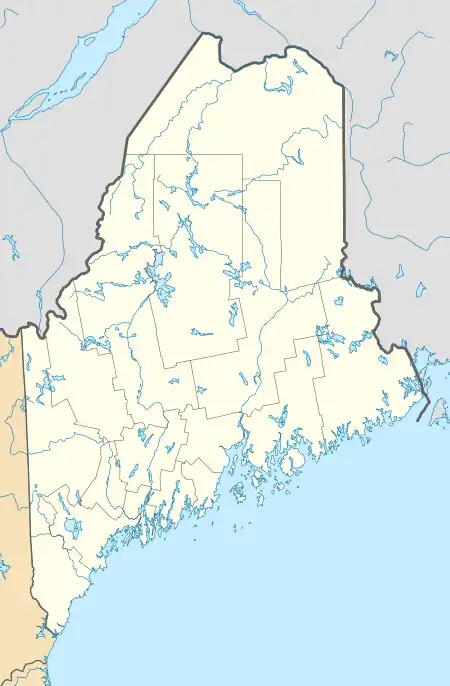Fort George | |
 Fort George - British fort built to defend their colony of New Ireland | |
  | |
| Location | Wadsworth St. off Battle Ave., Castine, Maine |
|---|---|
| Coordinates | 44°23′27″N 68°48′20″W / 44.39083°N 68.80556°W |
| Area | 7 acres (2.8 ha) |
| Built | 1779 |
| NRHP reference No. | 69000007[1] |
| Added to NRHP | December 30, 1969 |
Fort George (also sometimes known as Fort Majabigwaduce, Castine, or Penobscot) was a palisaded earthwork fort built in 1779 by Great Britain during the American Revolutionary War in Castine, Maine. Located at a high point on the Bagaduce Peninsula, the fort was built as part of an initiative by the British to establish a new colony called New Ireland. It was the principal site of the British defense during the Massachusetts-organized Penobscot Expedition, a disastrous attempt in July and August of 1779 to retake Castine in response to the British move. The British re-occupied Castine in the War of 1812 from September 1814 to April 1815, rebuilding Fort George and establishing smaller forts around it, again creating the New Ireland colony. The remains of the fort, now little more than its earthworks, are part of a state-owned and town-maintained park.
Description and history
Fort George is today a roughly square earthwork, about 200 feet (61 m) on each side, with bastions at the corners that project out an additional 40 feet (12 m). These works are for the most part about 10 feet (3.0 m) in height, although the easternmost bastion is 20 feet (6.1 m) high. Features of the fort that have not survived include a palisade, moat, and gateway.[2] The fort is one of a series of defenses erected by the British in 1779, which notably included the digging of a canal across much of the neck separating the Bagaduce Peninsula from the rest of the mainland.
Castine is set at a strategically significant location near the head of Penobscot Bay, and was a point of conflict at several times between the 17th and 19th centuries. Pursuant to plans for establishing a military presence on the coast of Maine as well as the colony of New Ireland, a British force led by General Francis McLean arrived off Castine in June 1779, seized the town, and established Fort George and other fortifications in the area. The state of Massachusetts, of which Maine was then a part, responded by raising a large militia force, which in an operation known as the Penobscot Expedition, disastrously failed in its attempt to dislodge the British in July and August of 1779.
The British established the fort under the command of a general named Campbell. There were about 30 houses in the area. They brought in prizes (captured ships and cargo) there, and received trade from British-controlled Halifax and New York. Loyalists from the surrounding area flocked to the village. A Loyalist guide for a party traveling from Falmouth (now Portland) to Fort George returned to his home in Camden afterwards and was later captured, court-martialed and executed by the Americans, tried by Major Benjamin Burton under the direction of Brigadier General Peleg Wadsworth. In revenge for this, a party of 25 Loyalists eventually went to Wadsworth's quarters and took him prisoner, also capturing Major Burton; they were incarcerated at Fort George. Wadsworth and Burton escaped on June 15, 1781 by cutting a hole in the roof of their jail.[3][4]
The fort was not abandoned by the British until 1784, and was not re-used by the United States until after the War of 1812.[2][5][6]
The British re-occupied Castine in the War of 1812 from September 1814 to April 1815, again establishing New Ireland. They rebuilt Fort George, renamed the captured Fort Madison (aka Fort United States) as Fort Castine,[7] and built Forts Furieuse,[8] Gosselin,[9] Griffith,[10] and Sherbrooke.[11][12] They also refurbished the peninsula's canal defense line. They withdrew after the cessation of hostilities, and following a brief period of American use, the fort was abandoned and demolished in 1819.[13]
The state of Maine acquired the fort in 1940, and twenty years later provided funds to rebuild a magazine with other improvements.[12] The site of the fort's remains is now a park of 7 acres (2.8 ha), owned by the state and maintained by the town.[14] The site was listed on the National Register of Historic Places in 1969.[1] Fort George is the site of Majabigwaduce, the location for Bernard Cornwell's 2010 book The Fort, which is about the Penobscot Expedition.
Gallery
 Ruined stone structure in a bastion of Fort George, possibly a magazine reconstructed in the 1960s
Ruined stone structure in a bastion of Fort George, possibly a magazine reconstructed in the 1960s Map of Fort George
Map of Fort George Britain defending New Ireland from the Penobscot Expedition by Dominic Serres
Britain defending New Ireland from the Penobscot Expedition by Dominic Serres
See also
References
- 1 2 "National Register Information System". National Register of Historic Places. National Park Service. July 9, 2010.
- 1 2 "NRHP nomination for Fort George". National Park Service. Retrieved 2015-02-12.
- ↑ Murdoch, Beamish (1866). A history of Nova-Scotia or Acadie, vol. II. Halifax, Nova Scotia: James Barnes. pp. 612–613.
- ↑ Dwight, Timothy (1821). Travels; in New-England and New-York, vol. II. New Haven: Timothy Dwight, S. Converse, printer. pp. 174–184.
- ↑ Wade, Arthur P. (2011). Artillerists and Engineers: The Beginnings of American Seacoast Fortifications, 1794-1815. CDSG Press. pp. 235–246. ISBN 978-0-9748167-2-2.
- ↑ The absence of Fort George from the Secretary of War's reports for 1808 and 1811 indicates that it was not used by the federal government at that time. The "Fort Georges" in the 1811 report is Fort St. George in Thomaston.
- ↑ Fort Madison aka Castine at FortWiki.com
- ↑ Fort Furieuse at FortWiki.com
- ↑ Fort Gosselin at FortWiki.com
- ↑ Fort Griffith at FortWiki.com
- ↑ Fort Sherbrooke at FortWiki.com
- 1 2 Roberts, Robert B. (1988). Encyclopedia of Historic Forts: The Military, Pioneer, and Trading Posts of the United States. New York: Macmillan. pp. 363–364, 373–374. ISBN 0-02-926880-X.
- ↑ Forts of Castine at NorthAmericanForts.com
- ↑ "Castine Comprehensive Plan, 2010" (PDF). Town of Castine. Retrieved 2015-02-12.
Bibliography
- Cornwell, Bernard (2010). The Fort. New York: HarperCollins. ISBN 9780007331727. Retrieved 2018-09-01. A historical novel depicting the Penobscot Expedition, with a non-fiction "Historical Note" (pp. 451–468) on sources and key details.
- Smith, Joshua M. Making Maine: Statehood and the War of 1812 Amherst, MA: the University of Massachusetts Press, 2022.